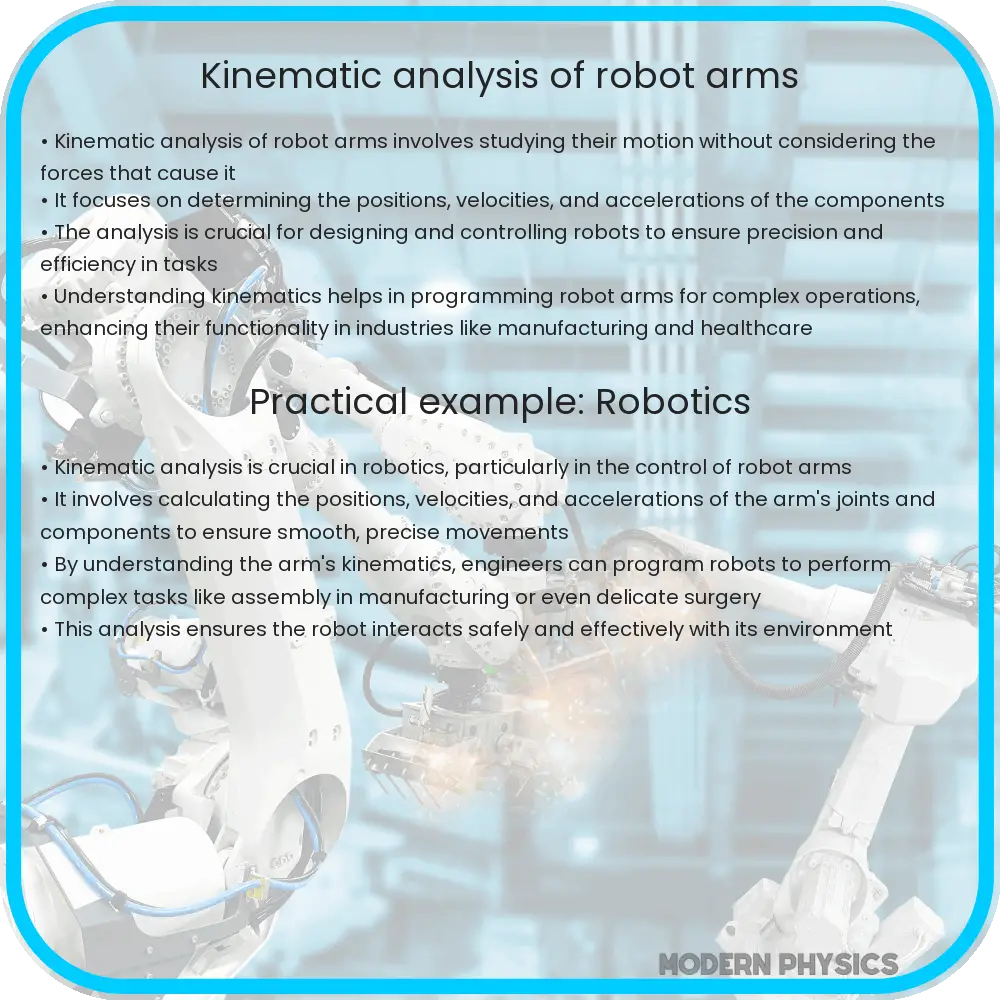Explore the essentials of kinematic analysis in robot arms, focusing on precision, speed, dynamics, and advanced modeling for optimal performance.

Kinematic Analysis of Robot Arms: Understanding Precision, Speed, and Dynamics
The field of robotics has witnessed significant advancements in recent years, with robot arms playing a pivotal role in various industrial, medical, and research applications. Kinematic analysis of these robotic arms is essential for optimizing their precision, speed, and overall dynamic performance. This analysis involves a comprehensive study of the movement and interaction of the arm’s segments under different operational conditions.
Precision in Robotic Arms
Precision is a critical factor in the performance of robot arms, especially in tasks requiring high accuracy, such as in assembly lines or surgical procedures. The precision of a robot arm is determined by its ability to reach a desired position and orientation with minimal deviation. This aspect is heavily influenced by the arm’s mechanical design, including the number and type of joints, and the control algorithms used for motion planning and correction.
- Mechanical Design: The design of joints and linkages in a robot arm directly impacts its precision. The use of high-quality bearings and rigid materials can reduce play and backlash in the joints, enhancing accuracy.
- Control Algorithms: Advanced control algorithms, such as Proportional-Integral-Derivative (PID) controllers or adaptive control systems, play a vital role in correcting deviations and maintaining precision during operation.
Speed and Efficiency
Speed is another crucial aspect of robotic arms, impacting their efficiency and throughput. Faster movement of the arm segments allows for quicker completion of tasks but can introduce challenges in maintaining accuracy and stability.
- Drive Systems: The selection of drive systems, such as servo motors or stepper motors, influences the maximum speed and acceleration of the robotic arm.
- Dynamics: The dynamic behavior of the arm, which includes factors like inertia and damping, affects its ability to move quickly without inducing vibrations or oscillations.
Dynamics and Control
The dynamics of a robot arm, encompassing its motion and forces, are pivotal in determining its overall performance. A thorough understanding of these dynamics is necessary for designing control systems that can effectively manage the arm’s movements in various scenarios.
In conclusion, the kinematic analysis of robot arms involves a multifaceted examination of their precision, speed, and dynamic characteristics. This analysis is fundamental to optimizing the performance of robotic arms for a wide range of applications, ensuring they operate with the desired accuracy and efficiency.
Advanced Modeling Techniques in Kinematic Analysis
To further enhance the capabilities of robot arms, advanced modeling techniques are employed in kinematic analysis. These techniques include computational methods and simulation tools that allow for the detailed examination of the robotic arm’s movements and interactions with its environment.
- Simulation Software: Simulation platforms, such as MATLAB or ROS (Robot Operating System), enable the virtual testing and fine-tuning of robotic arm designs before physical prototypes are constructed.
- Computational Kinematics: This involves the use of algorithms to calculate the position, velocity, and acceleration of each segment of the arm, considering the complex interplay of joints and linkages.
Application-Specific Considerations
The application for which a robot arm is designed significantly influences its kinematic properties. For example, robot arms used in precision assembly require high accuracy and repeatability, whereas those used in high-speed packaging operations prioritize speed and fluid motion.
- Customization for Specific Tasks: The kinematic parameters of a robot arm can be tailored to suit specific tasks, enhancing its effectiveness in particular applications.
- User Interface and Feedback Systems: Incorporating intuitive user interfaces and real-time feedback systems can greatly improve the ease of operation and monitoring of robotic arms.
Challenges and Future Trends
Despite the advancements in robotic technology, challenges remain in the field of kinematic analysis. These include dealing with complex environments, ensuring safety in human-robot interaction, and enhancing the adaptability of robotic arms to varied tasks. Future trends point towards the integration of artificial intelligence and machine learning techniques, which can enable robotic arms to learn and adapt to new tasks more efficiently.
Conclusion
Robot arms are a cornerstone of modern automation and robotics. The kinematic analysis of these arms is crucial for enhancing their precision, speed, and dynamic performance. By leveraging advanced modeling techniques, tailoring designs to specific applications, and overcoming current challenges, the field of robotics can continue to evolve, paving the way for more intelligent, adaptable, and efficient robotic systems. The integration of AI and machine learning in future developments promises to further revolutionize the capabilities of robot arms, making them an even more integral part of various industries and research fields.
